Science
Majestic wild horses are trampling Mono Lake’s otherworldly landscape. The feds plan a roundup

Several dozen horses calmly graze along the shores of Mono Lake, a sparkling saline expanse spread out before the jagged Sierra Nevada. The September sun is blazing. A pair of brown horses come up side by side and stare intensely at an approaching visitor.
These wild equines soon may disappear from beside the ancient lake. The prospect is stirring emotional disagreement over the future of the herd, which has surged to more than three times what federal officials say the land can support.
-
Share via
“These horses deserve a place to roam and be free, but around Mono Lake is not the place,” said Bartshe Miller of the Mono Lake Committee, an environmental nonprofit.
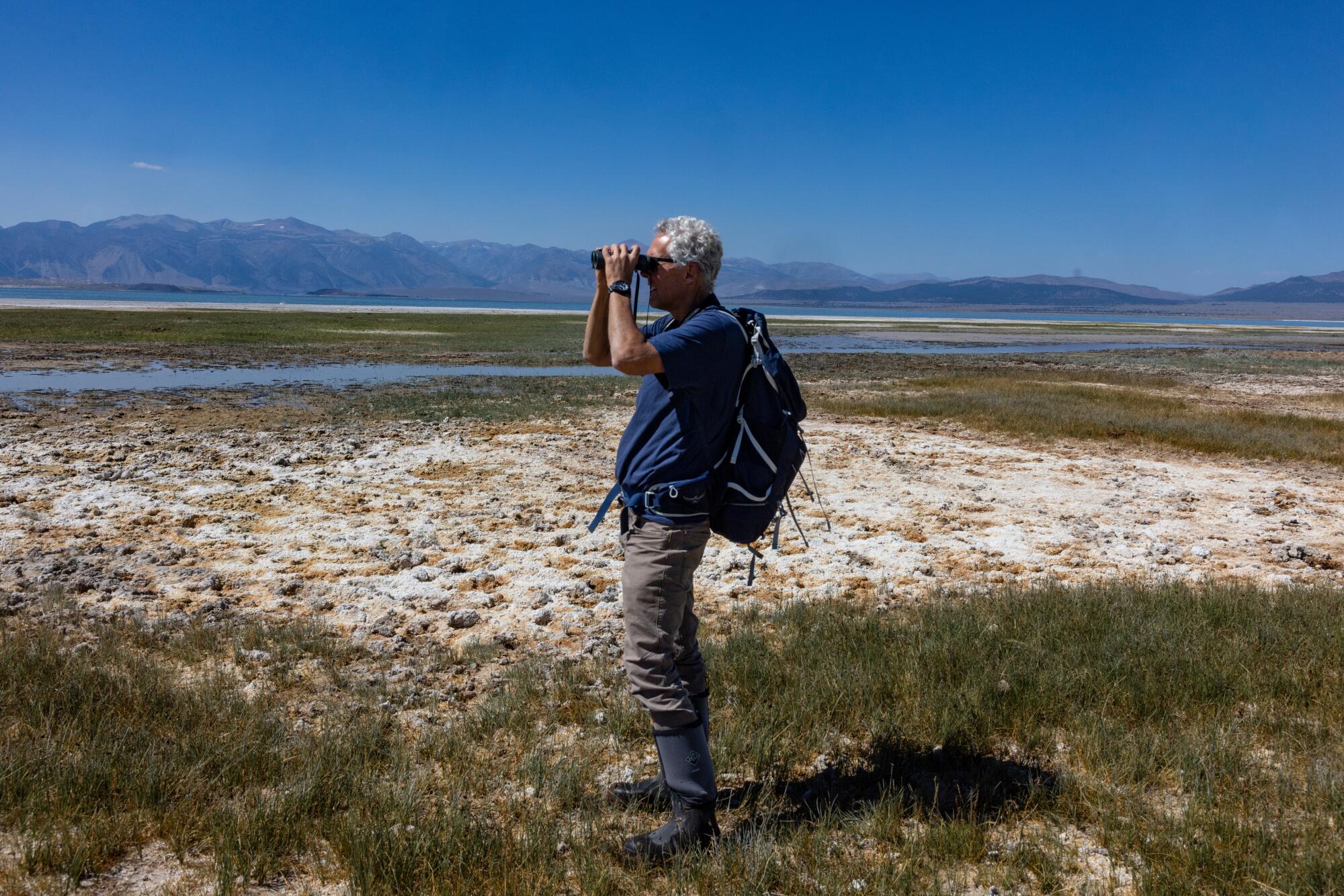
Bartshe Miller, Eastern Sierra policy director for the Mono Lake Committee, looks out onto the landscape at Warm Springs, a remote area on the east side of Mono Lake.
This year, the U.S. Forest Service and Bureau of Land Management approved a plan to round up and remove hundreds of wild horses roaming beyond the roughly 200,000 acres designated for them along the California and Nevada border. No date has been set, but it could be as soon as this fall.
It would be a relief for some. Environmentalists say the horses are degrading the otherworldly landscape at Mono Lake, including bird habitat and its famed tufa — textured rock columns that would look at home on Mars. Ranchers say the animals are gobbling down plants needed to sustain their cattle. Federal officials highlight the safety hazard posed by horses that have wandered onto highways.
Others see the move as a travesty. One method to oust the horses would use helicopters to drive them into a trap, which animal welfare groups say creates dangerous, even deadly, situations for horses. A pending federal bill would ban the practice.
Local tribes and nonprofits have partnered to fight the roundup plan, arguing that the Indigenous community should be tapped to manage the animals that roam their ancestral lands. A separate group of plaintiffs has sued the government, claiming it’s reneging on its duty to protect the horses.
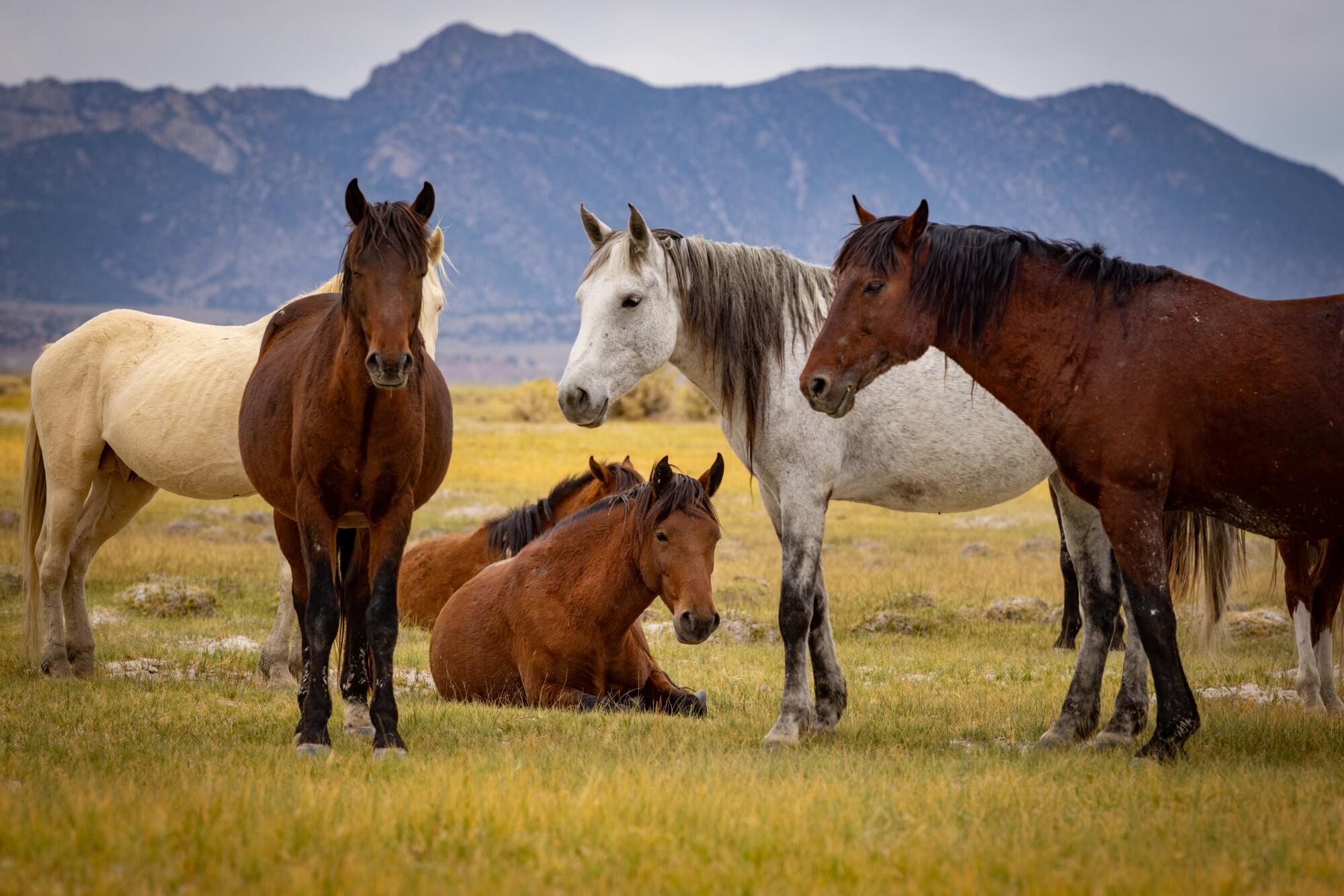
A group of horses roams near the community of Benton, Calif., not far from the Nevada border.
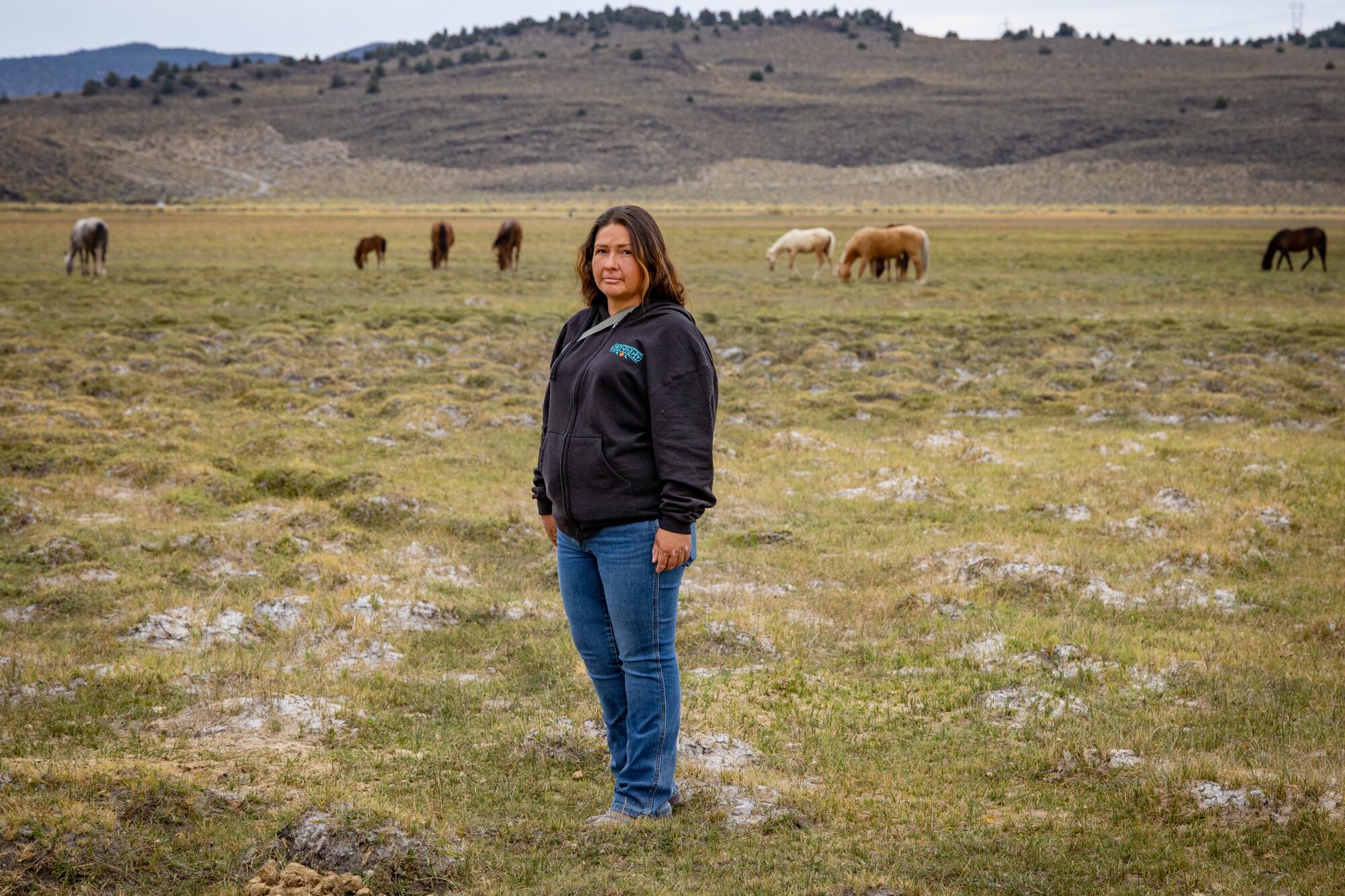
Ronda Kauk, of the Mono Lake Kootzaduka’a tribe, stands near wild horses.
“We’re all living spirits,” said Ronda Kauk, a member of the Mono Lake Kootzaduka’a tribe. “And it’s sad that people just don’t care about another living thing because they think it doesn’t belong there.”
Unseen evolution
For 36 years, Dave Marquart was part of a small team that monitored wetlands rimming Mono Lake, places so inaccessible even four-wheel drives can get stuck. Flung out far on the landscape, only wildlife could enjoy them. The area was a major nesting site for yellow-headed black birds, red-winged black birds, marsh wrens, soras and Virginia rails.
“There weren’t a lot of people that saw the transition that I saw, from healthy wetlands to completely trampled and devastated wetlands,” said Marquart, who was an interpretive naturalist for the Mono Lake Tufa State Natural Reserve until he retired in 2019. “It was quite a drastic change.”
Marquart recalled a time when he’d encounter fewer than 50 horses. They’d bolt when they saw his vehicle coming. That fear faded and their ranks grew. Over time, he said, they stamped ponds and urinated and defecated in the water. The birds stopped showing up.

Bartshe Miller holds grass he said was pulled up by the roots by wild horses roaming near Mono Lake. According to Miller, horses started arriving near the lake around 2015.
Before retiring, Marquart said, he helped organize a field trip involving the Forest Service, BLM and State Parks to showcase the impacts.
“Everybody saw that it was an issue and felt that something needed to be done,” he said.
Today, sizable mounds of horse manure dot Warm Springs, a remote area along the eastern edge of Mono Lake that Marquart had raised the alarm about during his tenure. White bones of fallen equines rest in the alkaline meadows. Chestnut fur gleamed on a hoof attached to a leg bone.
Miller, the Mono Lake Committee’s Eastern Sierra policy director, and Geoff McQuilkin, its executive director, led the way to a burbling spring rimmed by innumerable hoof prints. Surrounding vegetation was nibbled to nubs. Wildlife compete for the limited water here.

The bleached bones of a wild horse lie in vegetation near the shores of Mono Lake.
“The birds that would have a safe haven in that spring or be hidden away from raptors and predators overhead don’t have that opportunity anymore,” McQuilkin said.
The pair first remembered the horses showing up in remote areas around the lake in 2015, as the state was gripped by drought. By 2021, as they pushed west, they landed at South Tufa, where tourists congregate to gaze at the limestone columns. In the spring of 2023, horse carcasses emerged along the shores of South Tufa and nearby Navy Beach as the snow from a winter of biblical proportions melted.
“The recent deaths of these horses provide further evidence that the size of this herd cannot be supported by the landscape which they are expanding onto,” Lisa Cox, a spokesperson for the Inyo National Forest, said at the time.
‘They’re medicine’

Rana Saulque, vice chairwoman of the Utu Utu Gwaitu Paiute tribe, walks near a natural spring in an area where wild horses gather near the community of Benton, Calif.
On a pleasantly cool day in September, Rana Saulque stared transfixed at a group of roughly 50 wild horses in the River Spring Lakes Ecological Reserve, not far from her tribe’s reservation near the town of Benton.
Saulque, vice chairwoman for the Utu Utu Gwaitu Paiute tribe, draws a parallel between ousting the horses and the historical persecution of her people by the government.
“They’re going to run them down with helicopters and genocide them, just like they ran down us,” she said through tears.
A striking cremello horse stood out from the rest — a beloved subject for photographers who sojourn here. A brown foal with a white stripe on its muzzle teetered on toothpick legs. Several babies hugged close to their moms.
Mostly, the horses peacefully graze, but two rear up momentarily. “That’s horsing around,” Saulque said. Then they begin galloping and suddenly they look powerful and sleek. Epic, like a poster for a classic western film.

Dozens of wild horses graze on the River Spring Lakes Ecological Reserve.
“They’re so magical,” the vice chairwoman said. “They’re medicine for people.”
Federal officials stress that they have precautions in place to ensure safety during helicopter roundups. That includes avoiding peak foaling periods and hot weather that would stress the horses.
The Utu Utu Gwaitu Paiute are among a coalition that wants to pause the planned roundups for two years and ultimately secure land back to set aside a sanctuary for the horses to roam. As envisioned, local tribes would help manage the herd, including darting horses with a birth control vaccine to limit population growth. Horses could be put to work at pack stations, equine therapy and rodeo schools for kids, the group says.
The proposal could also help revive horse culture that runs deep in the tribal communities, Saulque said. Jim Walker, her great-great-grandfather and a respected medicine man, rode mustangs all the way to Florida, visiting tribes along the way to exchange medicine and horses.
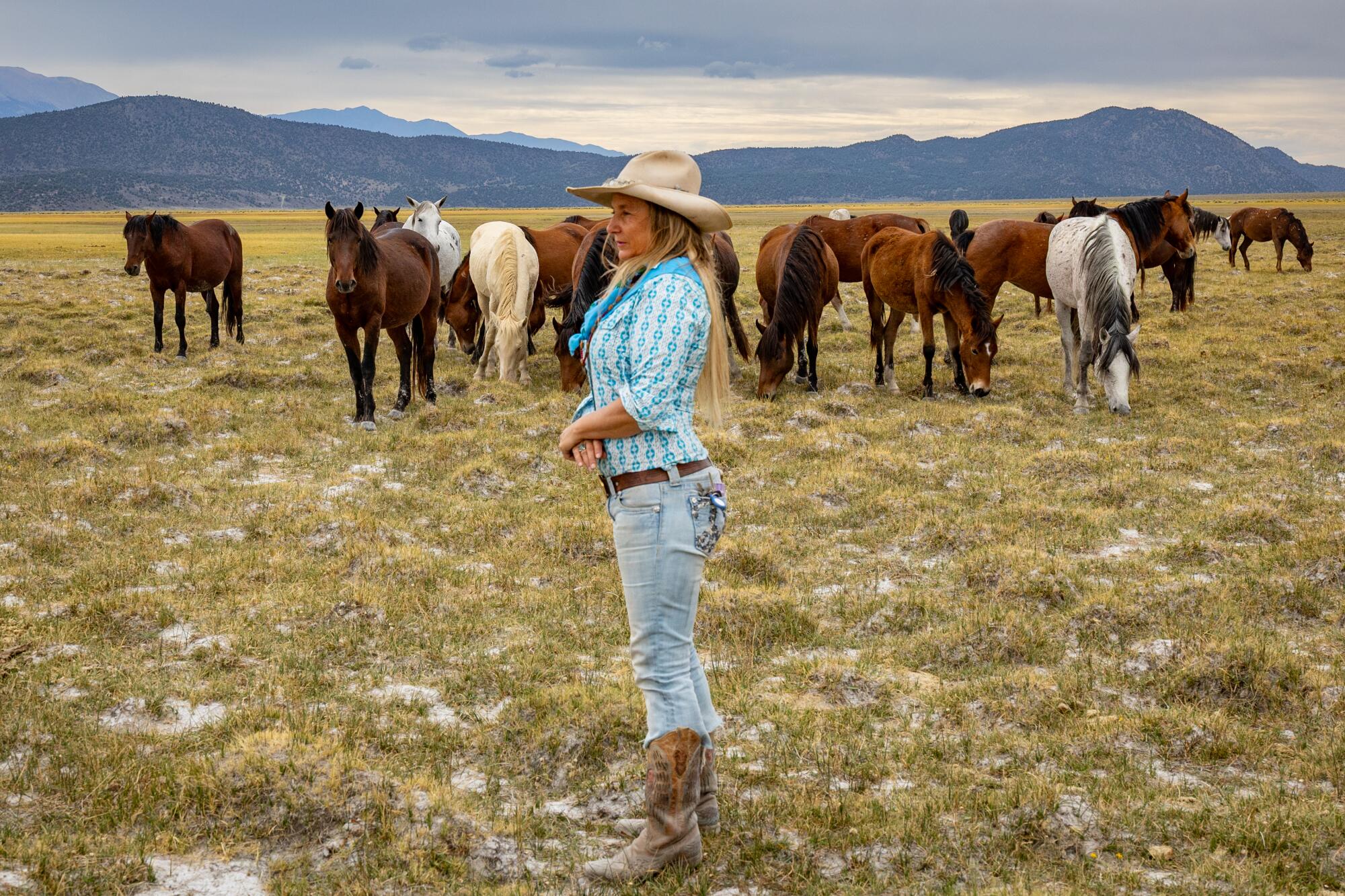
Maya Jamal Kasberg, founder of nonprofit Made by Mother Earth, is part of the coalition that wants to scrap the current plan to round up Montgomery Pass horses.
Kauk’s tribe historically rode the horses from Lee Vining into Yosemite to gather basket-making materials, among other activities. Mustangs were tapped for Native American rodeos and relay races, she added.
According to the coalition that includes the nonprofit American Wild Horse Conservation, federal officials and groups like the Mono Lake Committee have the science all wrong. The herbivores chomp down invasive cheatgrass that poses wildfire risk, and their poop — maligned by many — actually spreads native seeds, they say.
Wild and free — for now
At the heart of the emotional battle playing out in the Eastern Sierra is the Montgomery Pass wild horse herd. According to the U.S. Forest Service, its origin is unknown. But there’s speculation that it’s linked to mustang drives between the Owens Valley and Nevada.
A 1971 law declared wild horses and burros “living symbols of the historic and pioneer spirit of the West,” and made it illegal to harass, capture or kill them on public lands. But the Forest Service and BLM, which became responsible for managing them, can remove “excess animals” to preserve the health of the range.
The way this often plays out is that horses are rounded up and offered for adoption or sale. Those that aren’t taken in by a private owner are shipped to pastures where they often live out their remaining days.
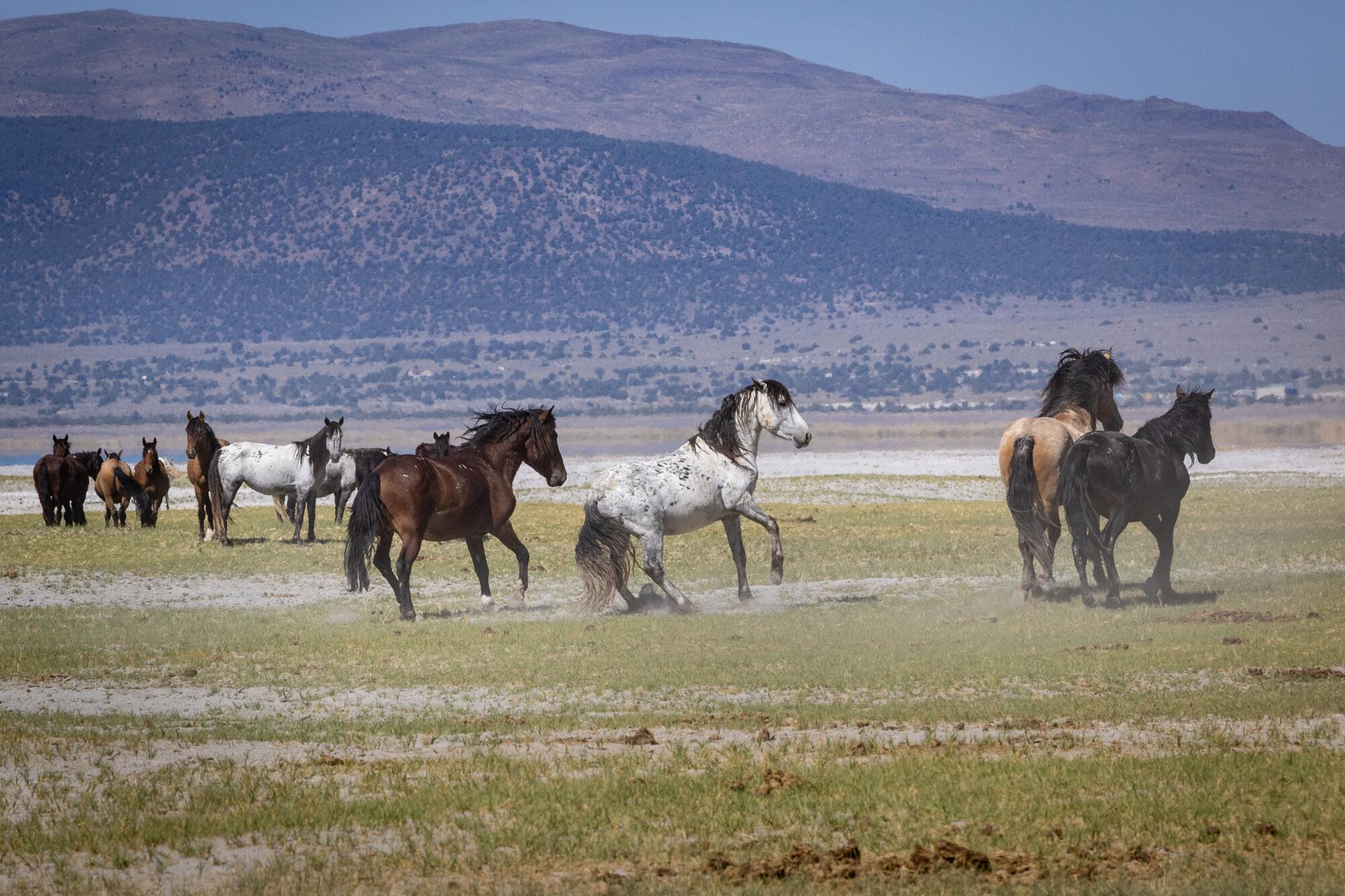
A census last year found that there are now about 700 horses in the Montgomery Pass herd.
Federal officials designated the Montgomery Pass Wild Horse Territory, a remote area spanning sagebrush steppe and pinyon pine forest east of Mono Lake. They say the land can sustainably support 138 to 230 horses.
As of last year, nearly 700 were documented in an aerial survey, with most ranging outside the territory, according to the agencies.
Now under a plan approved in March, up to 500 horses could be ousted, with the Forest Service leading the effort and BLM assisting.
Both agencies declined requests for interviews for this article, citing pending litigation. In August, a documentary filmmaker, primary care physician and wildlife ecologist sued the government authorities overseeing the agencies, claiming the roundups will decimate the herd to the point where long-term survival is unlikely.
“This case represents yet another attempt by the agencies to evade their statutory duties to protect, preserve and manage the herd,” the suit reads.
The government has agreed not to round up horses before Oct. 20, according to court documents.
When multiple uses collide
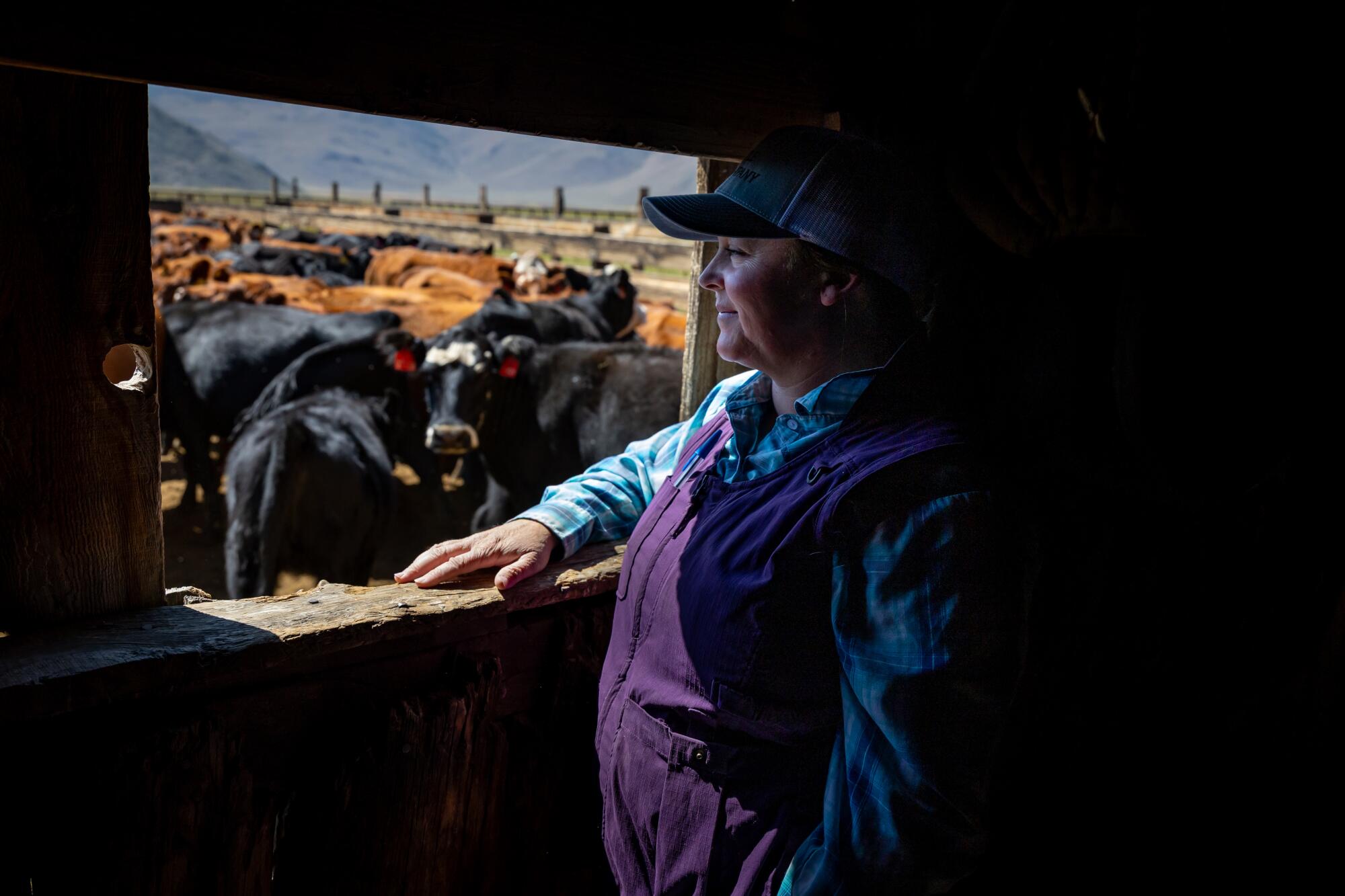
Rancher Leslie Hunewill looks at calves and their moms at her family’s historic ranch in Bridgeport.
Leslie Hunewill’s cattle ranching family sees quite a bit of “horse activity” on grazing lands in an area called the Mono Sand Flats, to the east and north of the lake. Since purchasing the right to use the public land, her outfit has been able to graze there for only about five weeks in the last two years — and not consecutively. The culprit? “A huge number of horses,” she said.
“Our cattle have not been out there,” she said. “There’s nothing for them to eat.”
Cows aren’t allowed on the roughly 50,000-acre expanse during the growing season. But the horses, facing no fences, go for what’s green and pushing up, she said.
“It doesn’t make sense for us to overuse or overgraze the land when we need to come back to it,” she said. “So when we are doing our part to manage the portion of it that we can, which is, say, our use of the cattle on that land, that’s all well and good. But who is taking charge of the horses and saying, this is too heavy use?”

The Hunewills, who have deep roots in the Eastern Sierra, operate a guest ranch in Bridgeport.
The law directs agencies to manage horse populations to maintain a “thriving natural ecological balance.” BLM and the Forest Service have to consider mustangs alongside grazing, wildlife and what’s good for the land. Some say the agencies have kicked the can down the road on management of the Montgomery Pass herd.
Hunewill’s family has deep roots in the Eastern Sierra. Her great-great-great-grandfather came to California in the 1860s as a gold miner. He struck it rich and got into the lumber business. When that stopped paying out, he used his oxen to feed the town of Bodie.
Her family is still in the beef business, with the meat generally staying on the West Coast.
They employ quite a few mustangs at their guest ranch operation in the town of Bridgeport, including Jethro, a friendly brown fella with a splash of white on his forehead. They’re hardy horses and can be enlisted as pack animals high up in the mountains. Some don’t need shoes because of their “great feet.”
But their robustness means “everybody’s already got their mustang,” she said, stymieing the prospect of mass adoptions.
Shifting dynamics
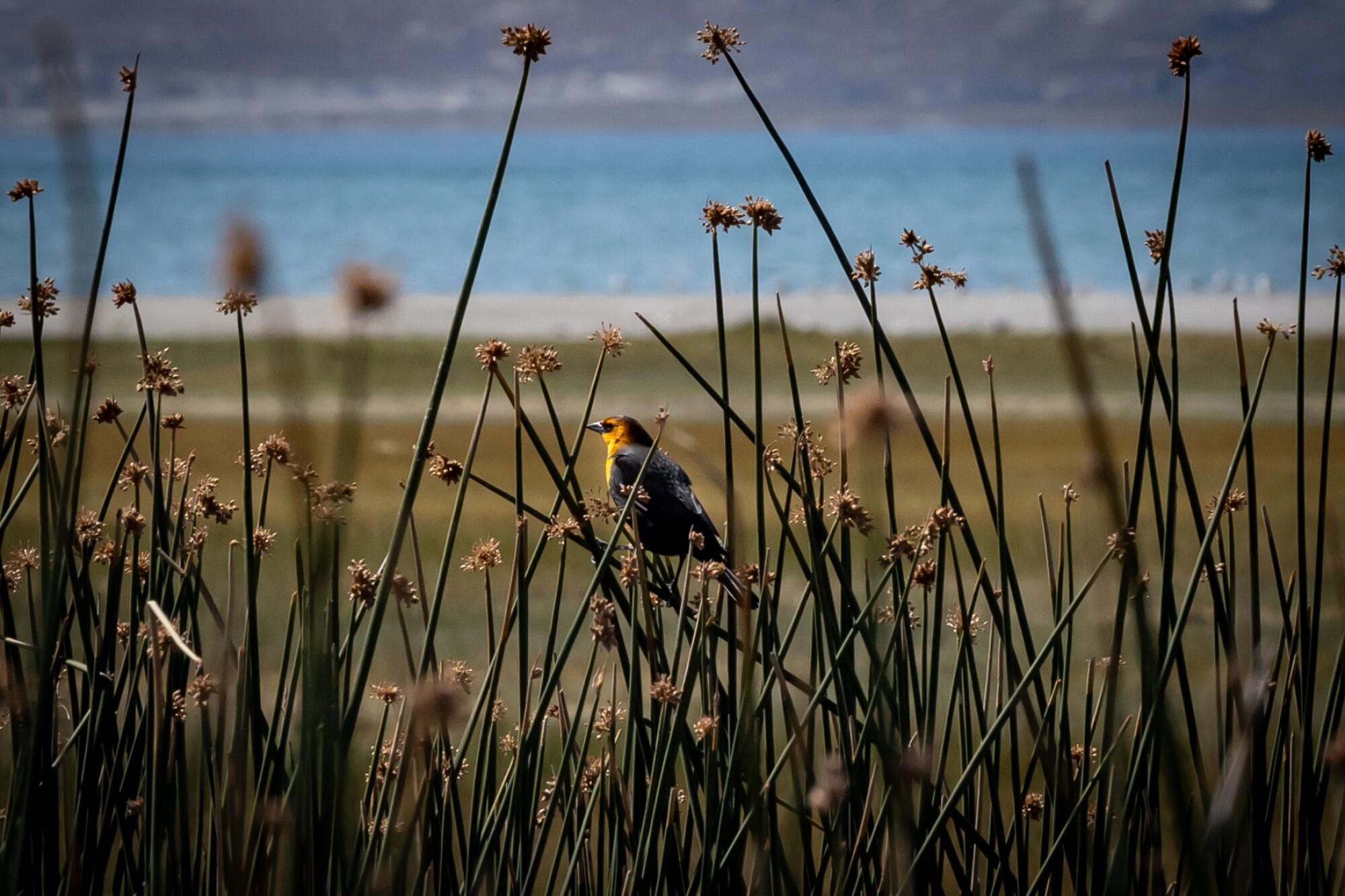
A bird perches in vegetation near Mono Lake.
Wild horse populations can increase as much as 20% a year. Montgomery Pass horses used to summer in the high country and were once kept in check by mountain lions that preyed on foals, according to John Turner, a professor at the University of Toledo College of Medicine, who studied the herd for decades.
That changed around 2008 or 2009, when the horses began lingering at lower elevations, where the open country makes it difficult for lions to hunt.
The herd’s population surged.
Turner sees the government’s current system of rounding up horses and holding them as unsustainable. And costly.
“The gathers are successful at that time, but the reproductive rate of the animals is greater than the capacity to remove them,” he said.

Science
Southern California mountain lions recommended for threatened status

The California Department of Fish and Wildlife has recommended granting threatened species status to roughly 1,400 mountain lions roaming the Central Coast and Southern California, pointing to grave threats posed by freeways, rat poison and fierce wildfires.
The determination, released Wednesday, is not the final say but signals a possibility that several clans of the iconic cougars will be listed under the California Endangered Species Act.
It’s a move that supporters say would give the vulnerable animals a chance at recovery, but detractors have argued would make it harder to get rid of lions that pose a safety risk to people and livestock.
The recommendation was “overdue,” Charlton Bonham, director of the state wildlife department, said during a California Fish and Game Commission meeting.
It arrives about six years after the Center for Biological Diversity and Mountain Lion Foundation petitioned the commission to consider listing a half-dozen isolated lion populations that have suffered from being hit by cars, poisoned by rodenticides and trapped by development.
The following year, in 2020 the Commission found the request might be warranted, giving the lions temporary endangered species protections as “candidates” for listing. It also prompted the state wildlife department to put together a report to inform the commission’s final decision.
The next step is for state wildlife commissioners to to vote on the protections, possibly in February.
Brendan Cummings, conservation director for Center for Biological Diversity, hailed the moment as “a good day, not just for mountain lions, but for Californians.”
If the commissioners adopt the recommendation, as he believes they will, then the “final listing of the species removes any uncertainty about the state’s commitment to conserving and recovering these ecologically important, charismatic and well-loved species that are so much a part of California.”
The report recommends listing lions “in an area largely coinciding” with what the petitioners requested, which includes the Santa Ana, San Gabriel, San Bernardino, Santa Monica, Santa Cruz and Tehachapi mountains.
It trims off portions along the northern and eastern borders of what was proposed, including agricultural lands in the Bay Area and a southeastern portion of desert — areas where state experts had no records of lions, according to Cummings.
Officials in the report note that most of the lion groups proposed for listing are contending with a lack of gene flow because urban barriers keep them from reaching one another.
In Southern California, lions have shown deformities from inbreeding, including kinked tails and malformed sperm. There’s an almost 1 in 4 chance, according to research, that mountain lions could become extinct in the Santa Monica and Santa Ana mountains within 50 years.
The late P-22 — a celebrity mountain lion that inhabited Griffith Park – personified the tribulations facing his kind. Rat poison and car collisions battered him from the inside out. He was captured and euthanized in late 2022, deemed too sick to return to the wild because of injuries and infection.
For some species, protections come in the form of stopping chainsaws or bulldozers. But imperiled lions, Cummings said, need their habitats stitched together in the form of wildlife crossings — such as the gargantuan one being built over the 101 Freeway in Agoura Hills. He added that developments that could restrict their movement should get more scrutiny under the proposed protections.
Critics of the effort to list lion populations have said that it will stymie residential and commercial projects.
California is home to roughly 4,170 mountain lions, according to the recent report, but not all are equal in their struggle.
Many lion populations, particularly in northwest coastal forests, are hearty and healthy.
Protections are not being sought for those cats. Some, in fact, would like to see their numbers reduced amid some high-profile conflicts.
Bonham, the director of the state Department of Fish and Wildlife, spoke to concerns about public safety at the recent meeting, alluding to the tragic death of young man who was mauled by a cougar last year in Northern California.
“These are really delicate issues and the conversation I know in the coming years is going to have to grapple with all that,” said Bonham, who will be stepping down this month after nearly 15 years in his role.
California’s lions already enjoy certain protections. In 1990, voters approved a measure that designated them a “specially protected species” and banned hunting them for sport.
Science
California’s last nuclear plant clears major hurdle to power on

California environmental regulators on Thursday struck a landmark deal with Pacific Gas & Electric to extend the life of the state’s last remaining nuclear power plant in exchange for thousands of acres of new land conservation in San Luis Obispo County.
PG&E’s agreement with the California Coastal Commission is a key hurdle for the Diablo Canyon nuclear plant to remain online until at least 2030. The plant was slated to close this year, largely due to concerns over seismic safety, but state officials pushed to delay it — saying the plant remains essential for the reliable operation of California’s electrical grid. Diablo Canyon provides nearly 9% of the electricity generated in the state, making it the state’s single largest source.
The Coastal Commission voted 9-3 to approve the plan, settling the fate of some 12,000 acres that surround the power plant as a means of compensation for environmental harm caused by its continued operation.
Nuclear power does not emit greenhouse gases. But Diablo Canyon uses an estimated 2.5 billion gallons of ocean water each day to absorb heat in a process known as “once-through cooling,” which kills an estimated two billion or more marine organisms each year.
Some stakeholders in the region celebrated the conservation deal, while others were disappointed by the decision to trade land for marine impacts — including a Native tribe that had hoped the land would be returned to them. Diablo Canyon sits along one of the most rugged and ecologically rich stretches of the California coast.
Under the agreement, PG&E will immediately transfer a 4,500-acre parcel on the north side of the property known as the “North Ranch” into a conservation easement and pursue transfer of its ownership to a public agency such as the California Department of Parks and Recreation, a nonprofit land conservation organization or tribe. A purchase by State Parks would result in a more than 50% expansion of the existing Montaña de Oro State Park.
PG&E will also offer a 2,200-acre parcel on the southern part of the property known as “Wild Cherry Canyon” for purchase by a government agency, nonprofit land conservation organization or tribe. In addition, the utility will provide $10 million to plan and manage roughly 25 miles of new public access trails across the entire property.
“It’s going to be something that changes lives on the Central Coast in perpetuity,” Commissioner Christopher Lopez said at the meeting. “This matters to generations that have yet to exist on this planet … this is going to be a place that so many people mark in their minds as a place that transforms their lives as they visit and recreate and love it in a way most of us can’t even imagine today.”
Critically, the plan could see Diablo Canyon remain operational much longer than the five years dictated by Thursday’s agreement. While the state Legislature only authorized the plant to operate through 2030, PG&E’s federal license renewal would cover 20 years of operations, potentially keeping it online until 2045.
Should that happen, the utility would need to make additional land concessions, including expanding an existing conservation area on the southern part of the property known as the “South Ranch” to 2,500 acres. The plan also includes rights of first refusal for a government agency or a land conservation group to purchase the entirety of the South Ranch, 5,000 acres, along with Wild Cherry Canyon — after 2030.
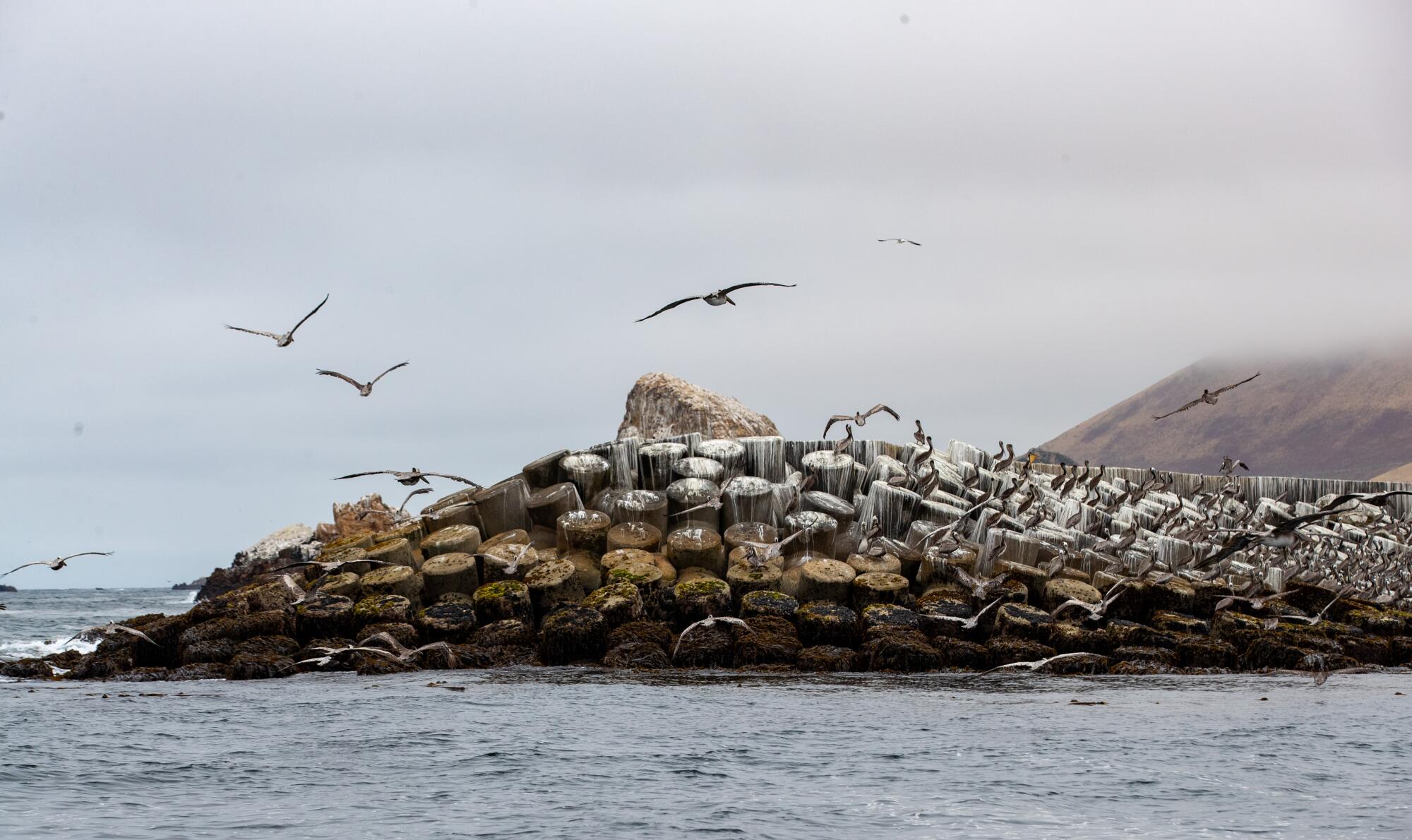
Pelicans along the concrete breakwater at Pacific Gas and Electric’s Diablo Canyon Power Plant
(Brian van der Brug/Los Angeles Times)
Many stakeholders were frustrated by the carve-out for the South Ranch, but still saw the agreement as an overall victory for Californians.
“It is a once in a lifetime opportunity,” Sen. John Laird (D-Santa Cruz) said in a phone call ahead of Thursday’s vote. “I have not been out there where it has not been breathtakingly beautiful, where it is not this incredible, unique location, where you’re not seeing, for much of it, a human structure anywhere. It is just one of those last unique opportunities to protect very special land near the California coast.”
Others, however, described the deal as disappointing and inadequate.
That includes many of the region’s Native Americans who said they felt sidelined by the agreement. The deal does not preclude tribal groups from purchasing the land in the future, but it doesn’t guarantee that or give them priority.
The yak titʸu titʸu yak tiłhini Northern Chumash Tribe of San Luis Obispo County and Region, which met with the Coastal Commission several times in the lead-up to Thursday’s vote, had hoped to see the land returned to them.
Scott Lanthrop is a member of the tribe’s board and has worked on the issue for several years.
“The sad part is our group is not being recognized as the ultimate conservationist,” he told The Times. “Any normal person, if you ask the question, would you rather have a tribal group that is totally connected to earth and wind and water, or would you like to have some state agency or gigantic NGO manage this land, I think the answer would be, ‘Hey, you probably should give it back to the tribe.’”
Tribe chair Mona Tucker said she fears that free public access to the land could end up harming it instead of helping it, as the Coastal Commission intends.
“In my mind, I’m not understanding how taking the land … is mitigation for marine life,” Tucker said. “It doesn’t change anything as far as impacts to the water. It changes a lot as far as impacts to the land.”

Montaña de Oro State Park.
(Christopher Reynolds / Los Angeles Times)
The deal has been complicated by jurisdictional questions, including who can determine what happens to the land. While PG&E owns the North Ranch parcel that could be transferred to State Parks, the South Ranch and Wild Cherry Canyon are owned by its subsidiary, Eureka Energy Company.
What’s more, the California Public Utilities Commission, which regulates utilities such as PG&E, has a Tribal Land Transfer Policy that calls for investor-owned power companies to transfer land they no longer want to Native American tribes.
In the case of Diablo Canyon, the Coastal Commission became the decision maker because it has the job of compensating for environmental harm from the facility’s continued operation. Since the commission determined Diablo’s use of ocean water can’t be avoided, it looked at land conservation as the next best method.
This “out-of-kind” trade-off is a rare, but not unheard of way of making up for the loss of marine life. It’s an approach that is “feasible and more likely to succeed” than several other methods considered, according to the commission’s staff report.
“This plan supports the continued operation of a major source of reliable electricity for California, and is in alignment with our state’s clean energy goals and focus on coastal protection,” Paula Gerfen, Diablo Canyon’s senior vice president and chief nuclear officer, said in a statement.
But Assemblymember Dawn Addis (D-Morro Bay) said the deal was “not the best we can do” — particularly because the fate of the South Ranch now depends on the plant staying in operation beyond 2030.
“I believe the time really is now for the immediate full conservation of the 12,000 [acres], and to bring accountability and trust back for the voters of San Luis Obispo County,” Addis said during the meeting.
There are also concerns about the safety of continuing to operate a nuclear plant in California, with its radioactive waste stored in concrete casks on the site. Diablo Canyon is subject to ground shaking and earthquake hazards, including from the nearby Hosgri Fault and the Shorline Fault, about 2.5 miles and 1 mile from the facility, respectively.
PG&E says the plant has been built to withstand hazards. It completed a seismic hazard assessment in 2024, and determined Diablo Canyon is safe to continue operation through 2030. The Coastal Commission, however, found if the plant operates longer, it would warrant further seismic study.
A key development for continuing Diablo Canyon’s operation came in 2022 with Senate Bill 846, which delayed closure by up to five additional years. At the time, California was plagued by rolling blackouts driven extreme heat waves, and state officials were growing wary about taking such a major source of power offline.
But California has made great gains in the last several years — including massive investments in solar energy and battery storage — and some questioned whether the facility is still needed at all.
Others said conserving thousands of acres of land still won’t make up for the harms to the ocean.
“It is unmitigatable,” said David Weisman, executive director of the nonprofit Alliance for Nuclear Responsibility. He noted that the Coastal Commission’s staff report says it would take about 99 years to balance the loss of marine life with the benefits provided by 4,500 acres of land conservation. Twenty more years of operation would take about 305 years to strike that same balance.
But some pointed out that neither the commission nor fisheries data find Diablo’s operations cause declines in marine life. Ocean harm may be overestimated, said Seaver Wang, an oceanographer and the climate and energy director at the Breakthrough Institute, a Berkeley-based research center.
In California’s push to transition to clean energy, every option comes with downsides, Wang said. In the case of nuclear power — which produces no greenhouse gas emissions — it’s all part of the trade off, he said.
“There’s no such thing as impacts-free energy,” he said.
The Coastal Commission’s vote is one of the last remaining obstacles to keeping the plant online. PG&E will also need a final nod from the Regional Water Quality Control Board, which decides on a pollution discharge permit in February.
The federal Nuclear Regulatory Commission will also have to sign off on Diablo’s extension.
Science
In search for autism’s causes, look at genes, not vaccines, researchers say

Earlier this year, Health and Human Services Secretary Robert F. Kennedy Jr. pledged that the search for autism’s cause — a question that has kept researchers busy for the better part of six decades — would be over in just five months.
“By September, we will know what has caused the autism epidemic, and we’ll be able to eliminate those exposures,” Kennedy told President Trump during a Cabinet meeting in April.
That ambitious deadline has come and gone. But researchers and advocates say that Kennedy’s continued fixation on autism’s origins — and his frequent, inaccurate claims that childhood vaccines are somehow involved — is built on fundamental misunderstandings of the complex neurodevelopmental condition.
Even after more than half a century of research, no one yet knows exactly why some people have autistic traits and others do not, or why autism spectrum disorder looks so different across the people who have it. But a few key themes have emerged.
Researchers believe that autism is most likely the result of a complex set of interactions between genes and the environment that unfold while a child is in the womb. It can be passed down through families, or originate with a spontaneous gene mutation.
Environmental influences may indeed play a role in some autism cases, but their effect is heavily influenced by a person’s genes. There is no evidence for a single trigger that causes autism, and certainly not one a child encounters after birth: not a vaccine, a parenting style or a post-circumcision Tylenol.
“The real reason why it’s complicated, the more fundamental one, is that there’s not a single cause,” said Irva Hertz-Picciotto, a professor of public health science and director of the Environmental Health Sciences Center at UC Davis. “It’s not a single cause from one person to the next, and not a single cause within any one person.”
Kennedy, an attorney who has no medical or scientific training, has called research into autism’s genetics a “dead end.” Autism researchers counter that it’s the only logical place to start.
“If we know nothing else, we know that autism is primarily genetic,” said Joe Buxbaum, a molecular neuroscientist who directs the Seaver Autism Center for Research and Treatment at the Icahn School of Medicine at Mount Sinai. “And you don’t have to actually have the exact genes [identified] to know that something is genetic.”
Some neurodevelopment disorders arise from a difference in a single gene or chromosome. People with Down syndrome have an extra copy of chromosome 21, for example, and Fragile X syndrome results when the FMR1 gene isn’t expressed.
Autism in most cases is polygenetic, which means that multiple genes are involved, with each contributing a little bit to the overall picture.
Researchers have found hundreds of genes that could be associated with autism; there may be many more among the roughly 20,000 in the human genome.
In the meantime, the strongest evidence that autism is genetic comes from studies of twins and other sibling groups, Buxbaum and other researchers said.
The rate of autism in the U.S. general population is about 2.8%, according to a study published last year in the journal Pediatrics. Among children with at least one autistic sibling, it’s 20.2% — about seven times higher than the general population, the study found.
Twin studies reinforce the point. Both identical and fraternal twins develop in the same womb and are usually raised in similar circumstances in the same household. The difference is genetic: identical twins share 100% of their genetic information, while fraternal twins share about 50% (the same as nontwin siblings).
If one fraternal twin is autistic, the chance that the other twin is also autistic is about 20%, or about the same as it would be for a nontwin sibling.
But if one in a pair of identical twins is autistic, the chance that the other twin is also autistic is significantly higher. Studies have pegged the identical twin concurrence rate anywhere from 60% to 90%, though the intensity of the twins’ autistic traits may differ significantly.
Molecular genetic studies, which look at the genetic information shared between siblings and other blood relatives, have found similar rates of genetic influence on autism, said Dr. John Constantino, a professor of pediatrics, psychiatry and behavioral sciences at the Emory University School of Medicine and chief of behavioral and mental health at Children’s Healthcare of Atlanta.
Together, he said, “those studies have indicated that a vast share of the causation of autism can be traced to the effects of genetic influences. That is a fact.”
Buxbaum compares the heritability of autism to the heritability of height, another polygenic trait.
“There’s not one gene that’s making you taller or shorter,” Buxbaum said. Hundreds of genes play a role in where you land on the height distribution curve. A lot of those genes run in families — it’s not unusual for very tall people, for example, to have very tall relatives.
But parents pass on a random mix of their genes to their children, and height distribution across a group of same-sex siblings can vary widely. Genetic mutations can change the picture. Marfan syndrome, a condition caused by mutations in the FBN1 gene, typically makes people grow taller than average. Hundreds of genetic mutations are associated with dwarfism, which causes shorter stature.
Then once a child is born, external factors such as malnutrition or disease can affect the likelihood that they reach their full height potential.
So genes are important. But the environment — which in developmental science means pretty much anything that isn’t genetics, including parental age, nutrition, air pollution and viruses — can play a major role in how those genes are expressed.
“Genetics does not operate in a vacuum, and at the same time, the impact of the environment on people is going to depend on a person’s individual genetics,” said Brian K. Lee, a professor of epidemiology and biostatistics at Drexel University who studies the genetics of developmental disorders.
Unlike the childhood circumstances that can affect height, the environmental exposures associated with autism for the most part take place in utero.
Researchers have identified multiple factors linked to increased risks of the disorder, including older parental age, infant prematurity and parental exposure to air pollution and industrial solvents.
Investigations into some of these linkages were among the more than 50 autism-related studies whose funding Kennedy has cut since taking office, a ProPublica investigation found. In contrast, no credible study has found links between vaccines and autism — and there have been many.
One move from the Department of Health and Human Services has been met with cautious optimism: even as Kennedy slashed funding to other research projects, the department in September announced a $50-million initiative to explore the interactions of genes and environmental factors in autism, which has been divided among 13 different research groups at U.S. universities, including UCLA and UC San Diego.
The department’s selection of well-established, legitimate research teams was met with relief by many autism scientists.
But many say they fear that such decisions will be an anomaly under Kennedy, who has repeatedly rejected facts that don’t conform to his preferred hypotheses, elevated shoddy science and muddied public health messaging on autism with inaccurate information.
Disagreements are an essential part of scientific inquiry. But the productive ones take place in a universe of shared facts and build on established evidence.
And when determining how to spend limited resources, researchers say, making evidence-based decisions is vital.
“There are two aspects of these decisions: Is it a reasonable expenditure based on what we already know? And if you spend money here, will you be taking money away from HHS that people are in desperate need of?” Constantino said. “If you’re going to be spending money, you want to do that in a way that is not discarding what we already know.”
-

 Alaska6 days ago
Alaska6 days agoHowling Mat-Su winds leave thousands without power
-
Ohio1 week ago
Who do the Ohio State Buckeyes hire as the next offensive coordinator?
-

 Texas6 days ago
Texas6 days agoTexas Tech football vs BYU live updates, start time, TV channel for Big 12 title
-

 Washington3 days ago
Washington3 days agoLIVE UPDATES: Mudslide, road closures across Western Washington
-

 Iowa5 days ago
Iowa5 days agoMatt Campbell reportedly bringing longtime Iowa State staffer to Penn State as 1st hire
-

 Miami, FL6 days ago
Miami, FL6 days agoUrban Meyer, Brady Quinn get in heated exchange during Alabama, Notre Dame, Miami CFP discussion
-

 Cleveland, OH5 days ago
Cleveland, OH5 days agoMan shot, killed at downtown Cleveland nightclub: EMS
-
World5 days ago
Chiefs’ offensive line woes deepen as Wanya Morris exits with knee injury against Texans


















